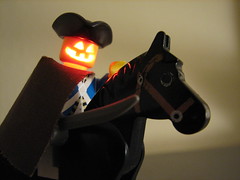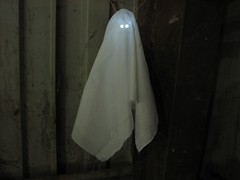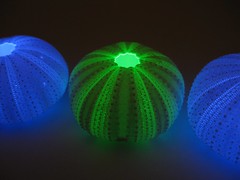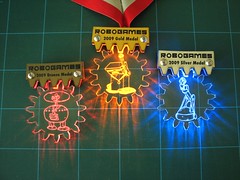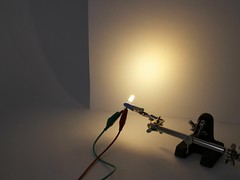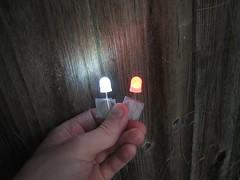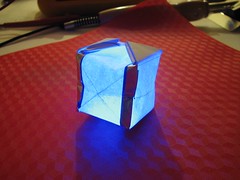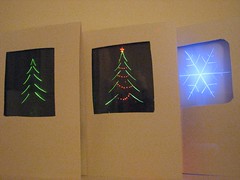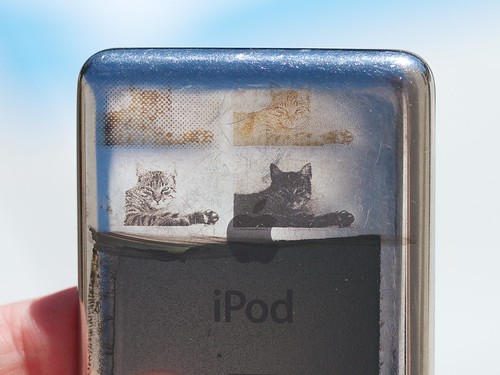Our friend John made Sconic Sections for a dinner party, with a slight variation: he baked the scone dough in ice cream cones. That led to a little bit of extra difficulty in slicing them, but the cone also provided an outline for the ellipses, hyperbolas and parabolas.
Roundup: Simple LED Projects
We’ve put together a roundup of our simplest LED projects; easy things to put together mostly with a bare LED and a coin cell.
Pictured above, Basics: Simple LED Pumpkins
How to hack LEDs into Lego minifigures for Halloween, and LED Ghosties for Halloween
LED-lit sea urchin shells, RoboGames Awards
Picking resistors for LEDs and Some thoughts on throwies
Quick, easy, temporary, and beautiful LED garden lights
Paper Circuitry at Home: Electric Origami, and the Soft circuitry merit badge
Edge-lit holiday cards and part II, Refining edge-it holiday cards
Automated Mechanical Maze Solver

Over on buildsmartrobots, Sai posted about a mechanical maze solving project. He uses an EBB (the same controller board we use on the Eggbot and the WaterColorBot) to control a couple of steppers to tilt the bed of the labyrinth using OpenCV to see both the path and the ball.
A few seconds of Octolively on vine
Alex Ray (@machinaut) has been playing with our Octolively open source interactive LED kits and says, “Physical computing interfaces are fun.”
Papercraft Seven Segment Clock

Instructables user alstroemeria has lovingly documented a clock build inspired by the D/A Clock by Alvin Aronson.


Each of the paper segments is moved in or out by a servo motor to make the mechanical digital display. The whole thing is run off of an Arduino with a servo controller board and a clock module.
Nicely done, Amazon

Amazon today decided to remind me about some of our past projects through book recommendations. We contributed a bunch of projects to The Hungry Scientist Handbook and were interviewed for Cooking for Geeks. Well targeted, Amazon— perhaps too well…
WaterColorBot at Kickstarter: One Day Left
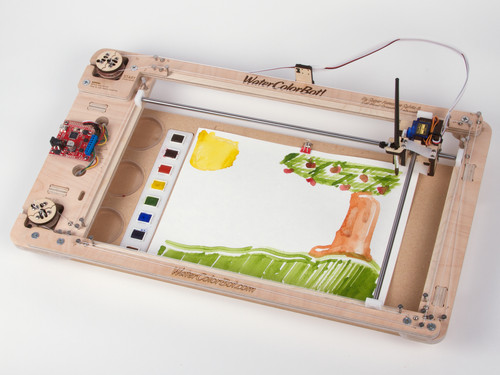
The Kickstarter campaign for Super Awesome Sylvia’s WaterColorBot is almost at a close, with just 24 hours remaining; it winds up tomorrow (Thursday) morning, at 7 AM eastern time.
So, if you haven’t signed up yet— and you think you might like to —this would be a great time to do so. If you’d like to learn more about the WaterColorBot, we’ve written a number of articles here on our blog, and there is also a detailed introduction on the Kickstarter page itself.
And for those of you who have backed our project, we are thrilled to have your support, and to have you along with us as we unleash so many art robots upon the world this fall. We can’t wait to see what kinds of amazing things people will create with them.
Artwork painted on the WaterColorBot by Robert “RoboGenius” Sloan.
Laser Marking with Moly
A low power CO2 laser cutter (like the one that we use) is fantastic for cutting and engraving wood, fabric, paper, and plastics. It’s also great for engraving painted or otherwise surface coated metal, like anodized aluminum (for example, making the labels on a Maglite).
However, with only a few exceptions, a laser like this generally falls down flat if you want to cut or engrave a chunk of bare metal. One exception is that you can actually cut through metal if it’s thin enough. Another is that you can make dark marks on metal with the help of a ceramic coating compound like CerMark. CerMark is sprayed on metal, then blasted with the laser so that it fuses to the surface, leaving a dark, permanent mark. Unfortunately, a spray can of CerMark costs $60, and as it is a specialty item, it may not be easily available when you happen to need it. So what do you do if you need something like this and you don’t have it?
Continue reading Laser Marking with Moly
Inside the ULN2003
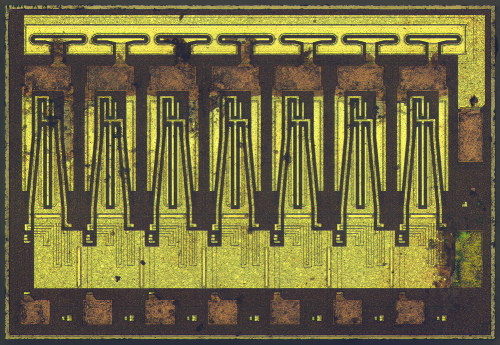
Over at ZeptoBars, they have an incredibly detailed “take-apart” post on what’s inside the ULN2003 seven channel Darlington driver chip. The ULN2003 is commonly used for driving LED displays—you can find it, for example, in our Mignonette game.
We often receive comments that while out microchip photos are beautiful and interesting, it is completely unclear how integrated circuit implements basic elements and form larger circuit. Of course it is impossible to do a detailed review of an 1’000’000 transistor chip, so we’ve found simpler example: ULN2003 – array of Darlington transistors.

They’ve stripped off the outer housing and put it under the microscope. They then analyzed the photos to show you what parts make up the individual transistors, resistors and diodes inside the chip.
Three Little Upgrades to the WaterColorBot
Even while the Kickstarter campaign for our WaterColorBot is in full swing, we’re continuing to improve its hardware design. Here are a select few of the refinements we have made since the last revision that will make the WaterColorBot better for everyone.






